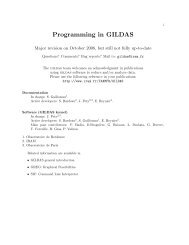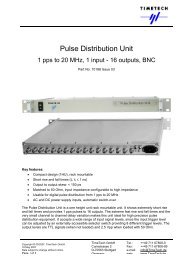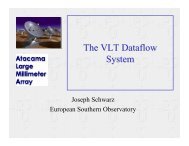class Continuum and Line Analysis Single-dish Software - IRAM
class Continuum and Line Analysis Single-dish Software - IRAM
class Continuum and Line Analysis Single-dish Software - IRAM
You also want an ePaper? Increase the reach of your titles
YUMPU automatically turns print PDFs into web optimized ePapers that Google loves.
4.4. CLASS FITS FORMAT 43<br />
more elaborate projection systems. In the current example, the position really observed is<br />
Dec = CRVAL3 + ( 1 - CRPIX3 ) * CDELT3<br />
Ra = CRVAL2 + ( 1 - CRPIX2 ) * CDELT2 / COS(Dec)<br />
That is, CDELT2 <strong>and</strong> CDELT3 represents angular offsets from the reference position<br />
(CRVAL2,CRVAL3) in a Global Sinusoidal projection (RADIO projection).<br />
7. Stokes parameters as defined in the basic paper of Wells et al.<br />
8. Galactic latitude <strong>and</strong> longitude of the reference position, i.e. of the position<br />
(CRVAL2,CRVAL3). If one was using galactic coordinates instead of equatorial ones, the<br />
RA <strong>and</strong> DEC would appear here instead.<br />
9. Epoch of these coordinates.<br />
10. Molecular line name, for bookkeeping.<br />
11. Rest frequency.<br />
12. LSR Velocity of the reference channel. Heliocentric velocities can be used also.<br />
13. Velocity spacings of the channels. This information is duplicate with the rest frequency<br />
<strong>and</strong> frequency spacing of channels, but convenient. The velocity of a given channel is thus<br />
given by<br />
V(i) = VLSR + ( i - CRPIX1 ) * DELTAV<br />
14. Image frequency, for double sideb<strong>and</strong> operation.<br />
15. System temperature, necessary for some kind of weighting when adding a number of spectra.<br />
16. Integration time, used for the same reason as above.<br />
17. Scan number, for bookkeeping.<br />
18. Atmospheric opacity in the signal sideb<strong>and</strong>.<br />
19. For multi-phased spectra (i.e. frequency switching) number of phases.<br />
20. For each phase, the frequency offset, the phase length <strong>and</strong> weight.<br />
21. The telescope beam efficiency.<br />
22. The telescope forward efficiency.<br />
23. The ratio of gains in the image <strong>and</strong> signal sideb<strong>and</strong>s (in case of double sideb<strong>and</strong> operation).<br />
24. Some “History” comments. Whether this information should be given with specific keywords<br />
or in an History record is still an open question. This information is not really needed<br />
for further data reduction, but it helps bookkeeping.<br />
25. The list of scan numbers of the spectra added to produce this one.<br />
The FITS interface for <strong>Continuum</strong> data is still experimental. Try it, <strong>and</strong> send your comments...






